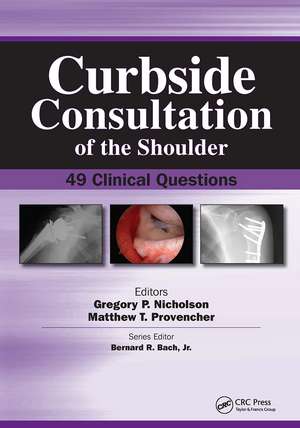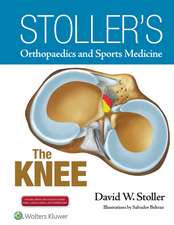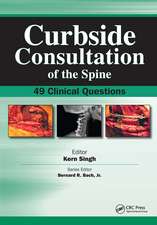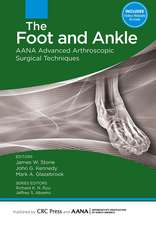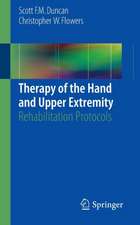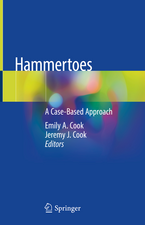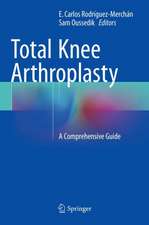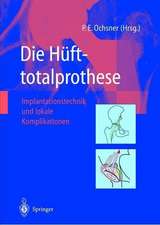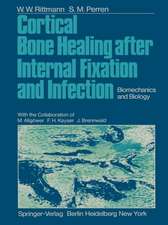Curbside Consultation of the Shoulder: 49 Clinical Questions: Curbside Consultation in Orthopedics
Autor Gregory Nicholson, Matthew Provencheren Limba Engleză Paperback – 15 iul 2008
Drs. Gregory P. Nicholson and Matthew T. Provencher have designed this unique reference which offers expert advice, preferences, and opinions on tough clinical questions commonly associated with the shoulder. The unique Q&A format provides quick access to current information related to the shoulder with the simplicity of a conversation between two colleagues. Numerous images, diagrams, and references are included to enhance the text and to illustrate the management of shoulders.
Curbside Consultation of the Shoulder: 49 Clinical Questions provides information basic enough for residents while also incorporating expert advice that even high-volume clinicians will appreciate. Practicing orthopedic surgeons, orthopedic residents, and medical students will benefit from the user-friendly and casual format and the expert advice contained within.
Some of the questions that are answered:
- How do you manage first time shoulder dislocations in a high level athlete?
- How do you diagnose and manage SLAP lesion, both in athletes and in laborers, and the impact of age on outcomes?
- What are the indications for long head of biceps tenotomy versus tenodesis in RC repair surgery?
- After an arthroscopic instability repair for recurrent anterior instability, when is the patient allowed to return to contact sports?
- What are the indications of ORIF of an acute fracture of the mid-shaft clavicle?
- What are the indications of ORIF and indications for hemiarthroplasty in the treatment of a proximal humerus fracture?
- When is arthroscopic closure of the rotator interval indicated in the setting of shoulder instability—anterior, posterior, multidirectional?
Preț: 848.36 lei
Preț vechi: 893.00 lei
-5% Nou
Puncte Express: 1273
Preț estimativ în valută:
162.33€ • 169.94$ • 134.32£
162.33€ • 169.94$ • 134.32£
Carte tipărită la comandă
Livrare economică 05-19 aprilie
Preluare comenzi: 021 569.72.76
Specificații
ISBN-13: 9781556428272
ISBN-10: 1556428278
Pagini: 236
Dimensiuni: 178 x 254 x 13 mm
Greutate: 0.58 kg
Ediția:First.
Editura: CRC Press
Colecția CRC Press
Seria Curbside Consultation in Orthopedics
ISBN-10: 1556428278
Pagini: 236
Dimensiuni: 178 x 254 x 13 mm
Greutate: 0.58 kg
Ediția:First.
Editura: CRC Press
Colecția CRC Press
Seria Curbside Consultation in Orthopedics
Public țintă
Professional Practice & DevelopmentCuprins
Contents Dedication Acknowledgments About the Editors Contributing Authors Preface SECTION I: PHYSICAL EXAMINATION QUESTIONS Question 1: What Are the Physical Examination Findings That Lead You to a Diagnosis of Glenohumeral Internal Rotation Deficit in the Throwing Athlete and What Nonoperative Treatment Options Have Led to Improvement of the Condition? Dan Solomon, MD Question 2: What Physical Examination Tests or Findings and Radiographs Do You Use to Diagnose Subacromial Impingement, and When Do You Utilize Subacromial Injections? Scott Youngblood, MD Question 3: What Are the Physical Examination Findings (Signs and Symptoms, Pertinent Positives and Negatives) That Direct You Toward a Diagnosis of Superior Labrum Anterior to Posterior Lesion? Dan Solomon, MD SECTION II: IMAGING QUESTIONS Question 4: A 19-Year-Old Male Has Suffered Four Recurrent Dislocations During Sporting Activity. He Has Been Able to Self-Reduce the Last Two Episodes. What Is the Advanced Imaging Study of Choice? Justin W. Chandler and Alex Creighton, MD Question 5: What Are the Radiographic Views Necessary to Evaluate Osteoarthritis of the Shoulder? Are These Adequate Prior to Total Shoulder Arthroplasty, or Is an Advanced Imaging Study (Computed Tomography Scan, Magnetic Resonance Imaging) Indicated? Samer S. Hasan, MD, PhD and David L. Saxton, MD Question 6: What Is the Imaging Modality To Best Diagnose a Superior Labrum Anterior to Posterior Tear and What Does It Look Like? Craig S. Mauro, MD and Mark W. Rodosky, MD SECTION III: SPORTS QUESTIONS Question 7: How Do You Manage the Long Head of Biceps Tendon in a 28-Year-Old Weekend Athlete With a Type IV Superior Labrum Anterior to Posterior Lesion That Involves Tearing Into the Biceps and Affects at Least 25% of the Tendon Thickness? Craig S. Mauro, MD and Mark W. Rodosky, MD Question 8: A Volleyball Hitter Has Weakness of External Rotation and Visible Atrophy of the Infraspinatus. What Are the Potential Causes, What Are the Indications for Suprascapular Nerve Decompression, and What Is the Operative Approach? Dan Solomon, MD Question 9: After a \u201cStinger\u201d During a Football Game, There Is Weakness of the Deltoid, Rotator Cuff, and Biceps and Triceps. Why Did This Happen and When Would You Allow Him to Return to Play Again? Justin W. Chandler and Alex Creighton, MD Question 10: When Is the Patient Allowed to Return to Contact Sports After an Arthroscopic Instability Repair for Recurrent Anterior Instability? K. Blair Sampson, MD and Samer S. Hasan, MD, PhD Question 11: What Is the Treatment for a Patient Who Presents With a \u201cSqueaking\u201d Shoulder 4 Months After an Arthroscopic Labral Repair Performed With a Bioabsorbable Tack? Craig S. Mauro, MD and Mark W. Rodosky, MD SECTION IV: PEDIATRIC QUESTIONS Question 12: A 14-Year-Old Pitcher Presents With Shoulder and Arm Pain. It Is Midseason. There Is No Instability, and the Pain Is Primarily Over the Lateral Deltoid. Radiographs Reveal Widening of the Lateral Aspect of the Proximal Humeral Physis. What Is the Diagnosis and Treatment Strategy? Christopher Dewing, MD, and Matthew T. Provencher, MD Question 13: How Do You Treat a 14-Year-Old Female Who Can Voluntarily Sublux the Shoulder Posteriorly and Anteriorly, and Has a Sulcus Sign? Ed Glenn, MD SECTION V: TRAUMA QUESTIONS Question 14: A 16-Year-Old Hockey Player Has a Collision With His Arm Forcibly Extended. A Magnetic Resonance Imaging Scan Reveals a Lesser Tuberosity Fracture With 2 to 3 mm of Elevation and 2 mm of Medial Displacement. Is This Due to the Apophysis of the Lesser Tuberosity? And How Do You Diagnose and Manage Traumatic Fractures of the Lesser Tuberosity of the Humerus? G. Peter Maiers, II, MD and Samer S. Hasan, MD, PhD Question 15: What Are the Indications for Open Reduction And Internal Fixation of an Isolated Greater Tuberosity Fracture, and What Approach and Operative Technique Is Appropriate? Anand Murthi, MD and Dori Kelly Question 16: What Are the Indications for Open Reduction And Internal Fixation of an Acute Fracture of the Midshaft Clavicle? Anand Murthi, MD Question 17: What Are the Indications for Open Reduction And Internal Fixation, and Indications for Hemiarthroplasty in the Treatment of Proximal Humerus Fracture? James M. Paci, MD and Matthew G. Scuderi, MD Question 18: What Are the Indications for Surgery in a Symptomatic Surgical Neck Nonunion, and Which Option (Open Reduction and Internal Fixation Or Arthroplasty) Would You Choose? Joseph Y. Choi, MD, PhD and Matthew G. Scuderi, MD SECTION VI: RECONSTRUCTION QUESTIONS Question 19: What Are the Indications and Options for Glenoid Resurfacing in Young Patients With Glenohumeral Degenerative Joint Disease? Joseph Y. Choi, MD, PhD and Matthew G. Scuderi, MD Question 20: What Are Your Indications for Repair of an Acute Pectoralis Major Tendon Tear and What Is Your Preferred Method of Fixation? Christopher Dewing, MD and Matthew T. Provencher, MD Question 21: A 40-Year-Old Laborer Has Shoulder Pain. An Electromyograph Reveals Chronic Denervation of the Serratus Anterior Muscle Without Reinnervation. What Is Your Preferred Treatment for a Patient With Chronic Symptomatic Winging of the Shoulder Due to Serratus Anterior Palsy? Chris Ahmad, MD and John Bell Question 22: How Do You Manage A Symptomatic Superior Labrum Anterior to Posterior II Tear In Someone Older Than 45 Years of Age? Tenotomy, Repair, or Tenodesis? Clifford G. Rios, MD; Robert A. Arciero, MD; Anthony A. Romeo, MD; and Augustus D. Mazzocca, MD Question 23: What Are the Indications for Conservative Treatment Versus Core Decompression Versus Arthroplasty in Avascular Necrosis of the Humeral Head? Sumant G. Krishnan, MD and Kenneth C. Lin, MD Question 24: A 70-Year-Old Patient Is Referred With A Magnetic Resonance Imaging Report That States a Supraspinatus Tear and Significant Degenerative Changes of the Glenohumeral Joint. Do You Counsel the Patient for Rotator Cuff Repair, Total Shoulder Replacement With Cuff Repair, or a Reverse Shoulder Replacement? Michael Pearl, MD Question 25: How Do You Work Up the Clinical Situation of Aseptic Loosening Versus Possible Occult Infection in a Total Shoulder With Incomplete 2-mm Lucent Lines Around the Cemented Glenoid? Gregory P. Nicholson, MD Question 26: A Patient With Shoulder DJD and in Need of a Shoulder Arthroplasty Has a Significant Loss of External Rotation at the Side of –15 Degrees Under Anesthesia. What Are the Options for Subscapularis Management, and What Approach Would Be Appropriate? Michael Pearl, MD Question 27: What Are the Relative Indications for Reverse Total Shoulder Arthroplasty? Michael Pearl, MD Question 28: There Is Atrophy of the Trapezius After Lymph Node Biopsy 18 Months Ago in the Posterior Cervical Triangle. What Are the Surgical Options and Techniques to Address Trapezius Muscle Palsy? Scott Youngblood, MD Question 29: What Is the Best Arthroplasty Option in a Shoulder With Rheumatoid Arthritis? Matthew D. Williams, MD and T. Bradley Edwards, MD Question 30: What Are the Indications for a Hemiarthroplasty Versus an Osteochondral Allograft in a Patient With a Locked Posterior Dislocation and Large Reverse Hill-Sachs Lesion? Michael Freehill, MD Question 31: What Is the Management of Symptomatic Subscapularis Deficiency After Previous Shoulder Surgery? Gregory P. Nicholson, MD SECTION VII: ROTATOR CUFF QUESTIONS Question 32: When Is It Appropriate to Begin Resistive Strengthening Exercises After the Repair of a 3.5-cm Supraspinatus Tear? R. Michael Gross, MD and Joseph Carney, MD Question 33: What Are the Indications for an Arthroscopic Subacromial Decompression in a Weekend Athlete With Shoulder Pain? R. Michael Gross, MD and Joseph Carney, MD Question 34: A 35-Year-Old Has Subacromial Impingement Symptoms. At Arthroscopy, a Hypermobile Meso-Acromiale—Unfused Acromial Epiphysis—Was Found. How Do You Manage a Patient With a Symptomatic Os Acromiale (Meso-Acromion) That Is Due to an Unfused Acromial Epiphysis? Sumant G. Krishnan, MD and Paul Jarman, MD Question 35: What Are the Indications for Long Head of Biceps Tenodesis Versus Tenotomy in a Patient Undergoing Rotator Cuff Repair? Clifford G. Rios, MD and Augustus D. Mazzocca, MD Question 36: What Are the Indications for D\u00e9bridement Versus Repair of a Partial Articular-Side Tendon Avulsion Lesion? Sumant G. Krishnan, MD and John Reineck, MD Question 37: What Are the Indications to Utilize a Rotator Cuff Augmentation Patch in the Repair of a Large or Massive Rotator Cuff Tear? Matthew T. Provencher, MD and Gregory P. Nicholson, MD Question 38: Magnetic Resonance Imaging Shows a 1-cm Supraspinatus Tear With 5 mm of Retraction and No Atrophy of the Muscle. What Are the Indications for Conservative Management Versus Surgical Intervention in a 55-Year-Old Golfer With Night Pain and Inability to Play Golf? John-Erik Bell, MD and Christopher S. Ahmad, MD SECTION VIII: INSTABILITY QUESTIONS Question 39: How Do You Evaluate a Patient After a Shoulder Trauma for a Posterior Dislocation? (The Patient Presents to You in the Sling 1 Week Later With –15 Degrees of External Rotation.) And If Dislocated, What Is Your Preferred Treatment? Anand Murthi, MD Question 40: At Arthroscopy for Anterior Instability, There Is an \u201cInverted-Pear\u201d Glenoid, or 20% to 25% Loss of the Anteroinferior Glenoid. What Would Be the Best Reconstructive Option With This Intraoperative Finding? Matthew D. Williams, MD and T. Bradley Edwards, MD Question 41: What Are the Typical Findings in a Patient With Posterior Instability and What Are the Indications for Open Versus Arthroscopic Posterior Instability Repair in a High School Offensive Lineman? A. Dushi Parameswaran, MD and Matthew T. Provencher, MD Question 42: How Do You Manage a High School Quarterback Who Dislocates His Throwing Shoulder (First Time Dislocation) in the First Game of the Season? And How Do You Manage a College Division 1 Quarteback Who Dislocates Their Shoulder in the First Game of the Season? John-Erik Bell, MD and Christopher S. Ahmad, MD Question 43: What Are the Preferred Management Options and Work-Up for an Individual Who Presents 1 Year After a Failed Arthroscopic Instability Repair? Rodney J. Stanley, MD and T. Bradley Edwards, MD Question 44: What Is the Optimal Placement of Suture Anchors in an Arthroscopic Anterior Instability Repair and How Much Capsular Tissue Should Be Tensioned in the Capsulolabral Repair? Ed Glenn, MD Question 45: How Do You Manage an Axillary Nerve Palsy After a Shoulder Dislocation? Michael Freehill, MD Question 46: When Is Arthroscopic Closure of the Rotator Interval Indicated in the Setting of Shoulder Instability—Anterior, Posterior, Multidirectional? Matthew T. Provencher, MD SECTION IX: ACROMIOCLAVICULAR QUESTION Chapter 47: How Do You Manage an Acute Grade III Acromioclavicular Separation and When Do You Allow Return to Work and/or Sport? What Are the Indications for Surgical Reconstruction of AC Separation? Clifford G. Rios, MD and Augustus D. Mazzocca, MD Chapter 48: A Weightlifter Has Osteolysis of the Distal Clavicle on a Zanca View Radiograph. The Pain Has Limited the Ability to Workout and Lift Weights. How Do You Work-Up and Manage a Patient With Acromioclavicular Joint Arthrosis? Justin W. Chandler and Alex Creighton, MD SECTION X: STIFFNESS QUESTION Chapter 49: What Are the Indications for Manipulation Under Anesthesia Versus Arthroscopic Release in a Patient With Stiffness After Rotator Cuff Repair? And When Do You Consider Operative Intervention in a Patient With Idiopathic Adhesive Capsulitis? Michael Freehill, MD Index
Notă biografică
Gregory P. Nicholson, MD is an Associate Professor of Orthopaedic Surgery at Rush University Medical Center in Chicago, Illinois. He is an author of numerous articles, papers, and chapters on conditions and injuries on the shoulder and elbow. He is a team physician for the Chicago White Sox baseball team. He is a member of the American Shoulder and Elbow Surgeons and American Orthopaedic Society for Sports Medicine.
Matthew T. Provencher, MD, LCDR, MC, USNR was born in New Hampshire, and completed his undergraduate education at the United States Naval Academy. There, he graduated with Distinction, was inducted into Phi Kappa Phi (National Honor Society), Tau Beta Pi (National Engineering Honor Soecity), Sigma Pi Sigma (National Physics Honor Society), and was named the Secretary of the Navy Distinguished Graduate. He was also a 4-year varsity oarsman and All-American at Navy. He completed his medical education at Dartmouth Medical School where he graduated with Honors and was elected to the Alpha Omega Alpha Honor Society. Matt completed his orthopaedic residency at the Naval Medical Center San Diego and his orthopaedic sports fellowship at Rush University under the direction of Bernard R. Bach, Jr, MD. Matt has been awarded the International Society of Arthroscopy, Knee Surgery and Orthopaedic Sports Medicine (ISAKOS) Science Award, the ISAKOS Richard Caspari Award (runner-up), the American Orthopaedic Society for Sports Medicine (AOSSM) Aircast Research Award, and was also both an AOSSM (Asia-Pacific) and an AOA John Fahey North American Traveling Fellow. Matt is currently the Assistant Director of Shoulder, Knee and Sports Surgery at the Naval Medical Center San Diego, a full-time academic practice. He is an active member of Arthroscopy Association of North America (AANA), AOSSM, ISAKOS, International Cartilage Repair Society (ICRS), and Society of Military Orthopaedic Surgeons (SOMOS).
Matthew T. Provencher, MD, LCDR, MC, USNR was born in New Hampshire, and completed his undergraduate education at the United States Naval Academy. There, he graduated with Distinction, was inducted into Phi Kappa Phi (National Honor Society), Tau Beta Pi (National Engineering Honor Soecity), Sigma Pi Sigma (National Physics Honor Society), and was named the Secretary of the Navy Distinguished Graduate. He was also a 4-year varsity oarsman and All-American at Navy. He completed his medical education at Dartmouth Medical School where he graduated with Honors and was elected to the Alpha Omega Alpha Honor Society. Matt completed his orthopaedic residency at the Naval Medical Center San Diego and his orthopaedic sports fellowship at Rush University under the direction of Bernard R. Bach, Jr, MD. Matt has been awarded the International Society of Arthroscopy, Knee Surgery and Orthopaedic Sports Medicine (ISAKOS) Science Award, the ISAKOS Richard Caspari Award (runner-up), the American Orthopaedic Society for Sports Medicine (AOSSM) Aircast Research Award, and was also both an AOSSM (Asia-Pacific) and an AOA John Fahey North American Traveling Fellow. Matt is currently the Assistant Director of Shoulder, Knee and Sports Surgery at the Naval Medical Center San Diego, a full-time academic practice. He is an active member of Arthroscopy Association of North America (AANA), AOSSM, ISAKOS, International Cartilage Repair Society (ICRS), and Society of Military Orthopaedic Surgeons (SOMOS).
Descriere
Curbside Consultation of the Shoulder: 49 Clinical Questions provides quick answers to the thorny questions most commonly posed during a "curbside consultation" between orthopedic surgical colleagues.
